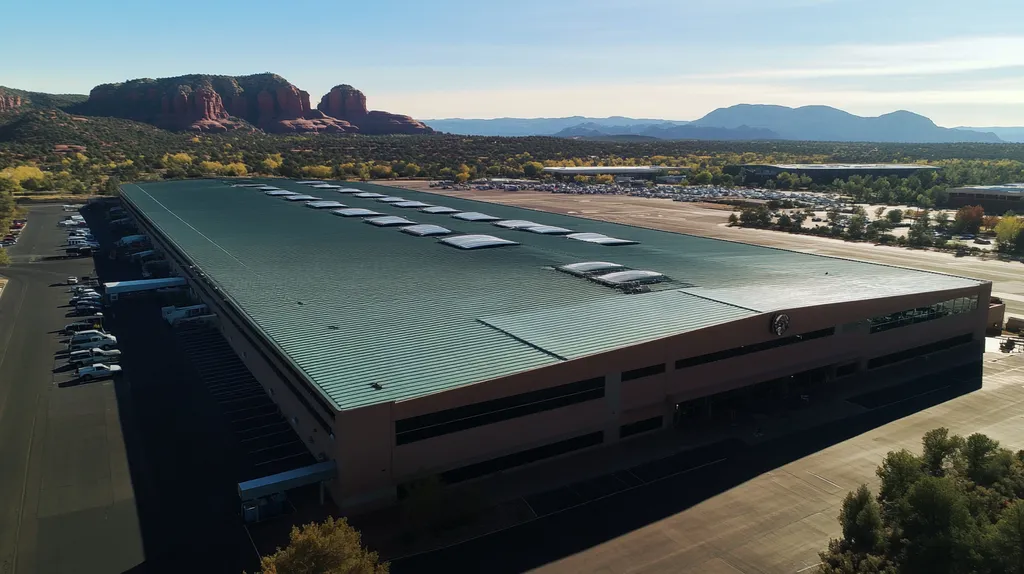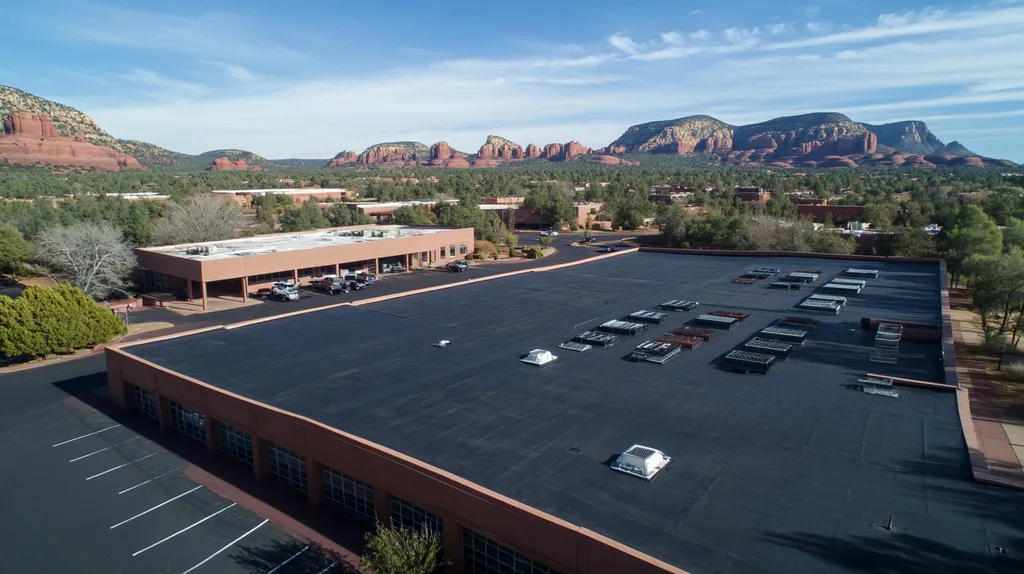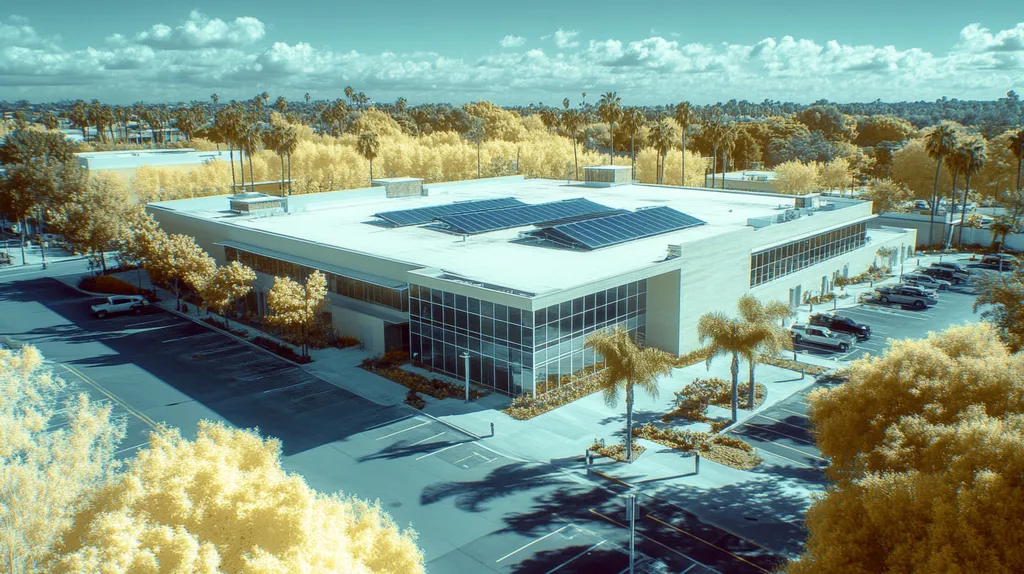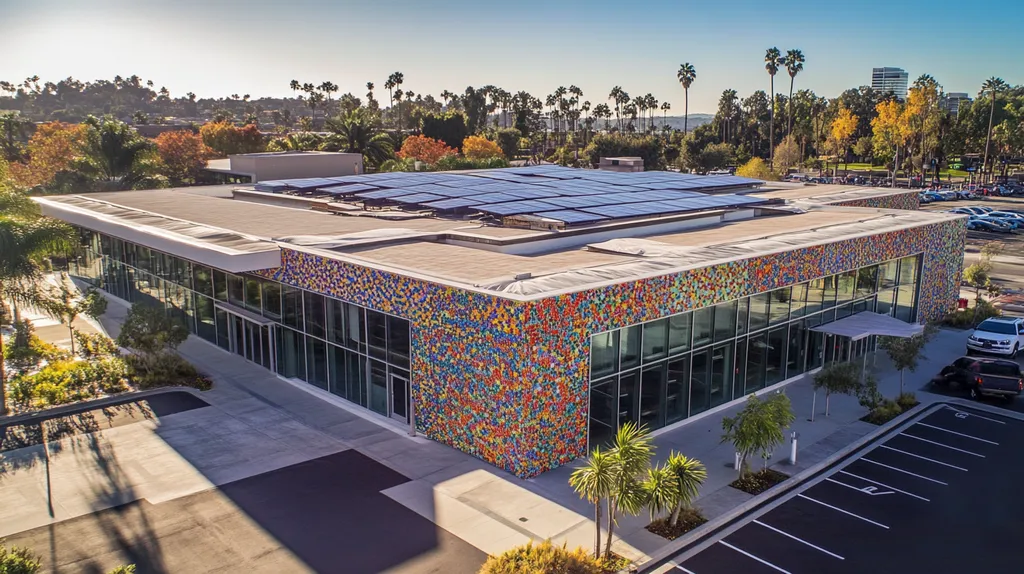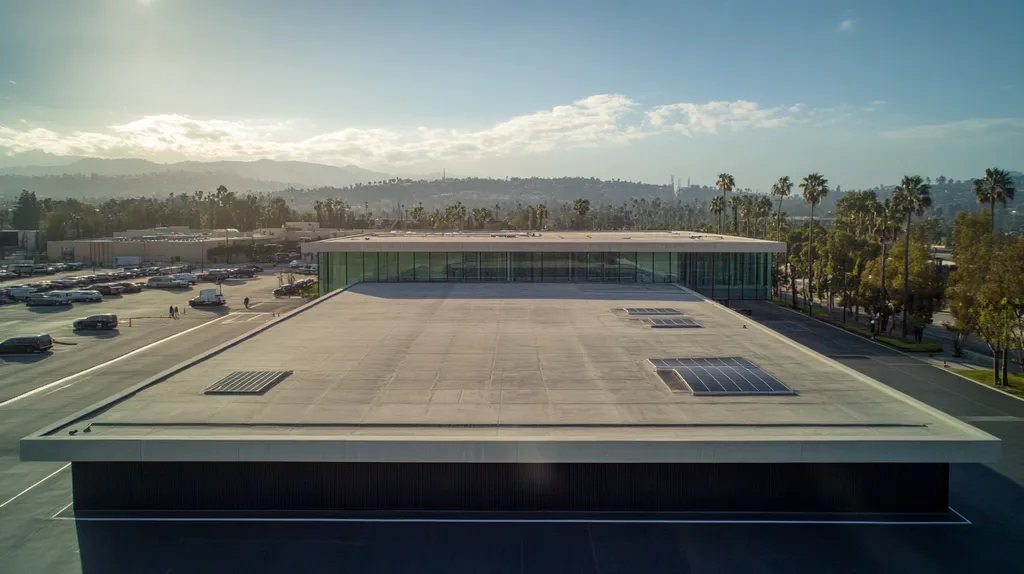Every year, thousands of commercial buildings face catastrophic damage and liability issues due to inadequate roof safety features, resulting in millions in preventable losses.
Modern commercial roofing systems now incorporate sophisticated safety elements that go far beyond basic fall protection, including advanced fire suppression, leak detection, and structural monitoring capabilities.
For property owners and facility managers, understanding these critical safety features isn’t just about compliance—it’s about protecting valuable assets and human lives while potentially reducing insurance costs by up to 25%.
This comprehensive guide breaks down essential safety components, practical applications, and decision factors to help property owners make informed choices about their roofing systems.
SECTION 1: THE BASICS EXPLAINED
Understanding the safety features of new commercial roof systems is crucial for protecting both buildings and their occupants. Poorly designed roofs can lead to serious issues like structural failures, costly water damage, and increased liability risks. Alarmingly, over 30% of building-related accidents involve roof activities, highlighting the urgent need for reliable safety measures. Property owners and facility managers must grasp these features to effectively mitigate risks and extend the lifespan of their roofs.
What It Is (In Plain Language)
Safety features in new commercial roof systems encompass a range of design elements and materials aimed at safeguarding both the building structure and its occupants. These include slip-resistant surfaces and integrated fall protection systems, all crafted to facilitate safe and efficient maintenance and inspections.
For example, roof guardrails act as a protective barrier, preventing workers from accidentally falling off edges. In addition, a robust roof deck provides the necessary support for maintenance staff and their equipment, reducing the risk of collapse.
Fire-resistant materials are another vital safety feature. They help contain fires, minimizing the risk to lives and valuable property.
Overall, these safety features create a safer working environment, making a significant difference in roofing operations for everyone involved.
Why It Matters (To Your Building)
Investing in enhanced safety features is essential for minimizing liability risks for property owners. Roofing accidents can lead to expensive lawsuits and insurance claims that threaten a business’s financial well-being. By prioritizing these safety measures, property owners show a strong commitment to workplace safety.
Additionally, a safe roof can lower insurance premiums. Insurers often reward buildings with solid safety features, leading to substantial savings over time.
Moreover, increased safety contributes to operational efficiency. When maintenance teams work in secure environments, they can complete tasks more quickly and with less downtime.
Consequently, investing in safety features is not just a cost—it’s a smart financial decision that can pay off in numerous ways over time.
How It Works
Safety features function through thoughtful engineering and design in commercial roofing systems. For instance, an effective drainage system can prevent water buildup, thereby minimizing both structural damage and slip hazards.
Moreover, slip-resistant coatings or textured surfaces on rooftops provide crucial traction, enhancing safety for maintenance crews.
Fall protection systems, including harnesses and anchored lifelines, ensure that personnel can conduct roof work safely, without fears of falling.
Together, these features form a comprehensive safety strategy in roof management, ensuring ongoing protection for both the structure and its users. By understanding how these components interact, property owners empower themselves to make informed decisions regarding their roofing systems.
SECTION 2: PRACTICAL APPLICATIONS
The practical applications of safety features in new commercial roof systems are indispensable for property owners. With over 30% of roofing-related accidents stemming from insufficient safety protocols, the stakes are undeniably high. This alarming statistic highlights the imperative of incorporating robust safety features into roofing designs. Property owners must recognize that these enhancements safeguard both assets and personnel. The following sections will underscore common applications, key moments when features are most needed, and how these safety elements interact with other building systems.
Common Uses & Examples
Safety features on commercial roofs serve critical functions across various applications, including guardrails, safety nets, and dedicated fall protection systems. These elements are essential during maintenance and inspection activities, which are often frequent. For example, fall protection systems can dramatically reduce workplace injuries in manufacturing facilities.
In a retail environment, guardrails surrounding rooftop HVAC units allow employees to service equipment without compromising their safety. Similarly, installing safety nets on expansive rooftops helps mitigate risks associated with unexpected slips. Implementing these safety measures is not just about meeting regulations—it’s a strong commitment to safeguarding employee well-being.
Moreover, specific roof configurations may call for customized solutions. In busy areas with high foot traffic, specialized support structures can enhance both safety and durability. By understanding these prevalent applications, property owners can make more informed decisions regarding their safety enhancements.
When You Need It Most
Recognizing when safety features are most critical is vital for effective risk management. The demand for such features escalates during roof installations, inspections, and maintenance activities, as these periods are statistically when most accidents occur. Incorporating safety features during the design phase ensures they blend seamlessly into the overall roof architecture.
Environmental conditions also dictate the necessity for enhanced safety measures. Areas prone to heavy snowfall or high winds must have roofs designed with these factors in mind. Incorporating effective drainage systems and secure anchor points is essential to prevent accidents in these challenging scenarios.
Furthermore, facilities with frequent roof access—like those housing HVAC systems—should prioritize robust safety features. By understanding these critical timeframes, property owners can make proactive choices to boost overall safety.
Interactions With Other Systems
Safety features on roofing systems frequently interact with other building components, shaping overall performance. For instance, when installing guardrails, compatibility with existing HVAC and electrical systems must be prioritized. This alignment ensures that vital systems remain intact while maximizing safety.
Additionally, the interaction between a roof’s drainage system and its safety features deserves attention. Proper drainage is essential to prevent water accumulation that could lead to hazardous conditions during maintenance tasks. Neglecting drainage can result in significant operational disruptions and heightened injury risks.
Moreover, safety features can streamline how other systems are maintained. For instance, clearly categorized safety access points facilitate safer interactions between roof technicians and operational staff. This coordination minimizes the likelihood of accidents, contributing to a safer working environment for everyone involved.
SECTION 3: KEY TERMINOLOGY DECODED
Grasping roofing terminology is vital for property owners and facilities managers involved with commercial roof systems. Misunderstandings can lead to serious safety issues and costly repairs. A lack of clarity around terms like “ballast” or “drainage” can compromise installation quality. This section will clarify essential roofing terms, break down confusing industry jargon, and simplify measurements. Understanding these terms empowers property owners to improve safety and engage effectively with their roofing professionals.
Essential Terms Explained
In the world of commercial roofing, terms such as “membrane,” “flashings,” and “decking” frequently come into play. A membrane acts as a waterproof barrier, safeguarding the building from water infiltration. Flashings are the materials used to prevent water from seeping into joints or seams. Decking refers to the structural layer providing support for the roofing system.
Understanding these components is crucial for maintaining the roof’s integrity. A durable membrane significantly reduces leaks, while the right flashings help seal off potential moisture entry points. Property owners should familiarize themselves with these terms to communicate their needs clearly with contractors.
This knowledge not only aids in interactions with roofing professionals but also allows property managers to evaluate service proposals more effectively. Recognizing the differences among membrane types can lead to more informed decisions regarding materials and applications.
Ultimately, a clear understanding of roofing terminology fosters collaboration and ensures safer environments, enhancing overall building safety.
Industry Jargon Translated
Industry jargon often creates barriers between contractors and property owners. Important terms like “R-value” and “U-factor” can be crucial yet confusing. The R-value measures insulation effectiveness, while the U-factor indicates the efficiency of heat transfer. Understanding these metrics is essential for evaluating roofing systems for energy efficiency.
When it comes to safety, knowing these terms empowers property owners to make informed decisions that enhance energy efficiency and comfort. A high R-value suggests better insulation, directly impacting energy costs and temperature control.
Additionally, other terms such as “pitch” and “drainage” are valuable to comprehend. The pitch refers to the roof’s steepness, crucial for water runoff. Proper drainage systems are essential to prevent water pooling that can lead to leaks and structural damage. Recognizing these terms helps inform appropriate maintenance routines and safety practices.
By demystifying this jargon, property managers can advocate for roofing systems tailored to their specific needs, ensuring enhanced safety and functionality.
Measurement & Units Simplified
Accurate measurements and units are fundamental when evaluating roofing systems. Understanding square footage is crucial, as roofing materials are commonly sold by the square—equivalent to 100 square feet. This unit enables property owners to calculate their material requirements accurately.
Another critical measurement is the “mil,” which assesses membrane thickness. Thicker membranes typically offer enhanced durability and longevity. For instance, a 60-mil membrane provides significantly more protection compared to a thinner variant.
Understanding slope ratios also clarifies drainage needs. For example, a roof with a slope of 1:12 means it rises one foot for every twelve feet horizontally. This measurement is vital for effective water drainage, directly affecting safety and maintenance routines.
By grasping these measurements, property owners can deepen their understanding of roofing systems, ensuring that their investments in safety features align with their building requirements.
SECTION 4: DECISION FACTORS
When evaluating new commercial roof systems, the stakes could not be higher. Property owners must consider safety features that extend beyond superficial aesthetics and initial costs. A flawed roof can lead to devastating financial losses, accidents, or even catastrophic structural failures. Therefore, grasping the implications of cost, performance trade-offs, and lifespan is crucial for making informed decisions that prioritize both safety and operational efficiency.
Cost Considerations
Cost is a paramount factor in selecting a new roof system for commercial properties. While a lower initial investment may be tempting, it’s vital to look beyond upfront prices. Cheaper materials often lack essential safety features, resulting in higher maintenance costs down the line.
For instance, opting for a roof without a fire-resistant layer may seem budget-friendly initially but could expose property owners to greater risks and potential liability claims. The challenge lies in balancing immediate budget constraints with the long-term safety and compliance expenses.
Investing in high-quality materials with built-in safety features can yield significant savings over time. Enhanced safety often translates to lower insurance premiums and fewer costly repairs, proving that investing in safety can deliver financial advantages.
A thorough cost-benefit analysis allows property owners to discern the real cost of cheaper alternatives. Understanding the long-term financial ramifications ensures that the selected roof system strikes a solid balance between safety and affordability.
Performance Trade-offs
Performance is another critical consideration when selecting a commercial roof. Different roofing materials offer varying levels of safety features such as slip resistance and weight tolerance. Choosing the wrong material can lead to performance issues that jeopardize safety.
For example, while single-ply membranes might be cost-effective, they often lack the sturdiness of reinforced roofs, which can cause failures during severe weather. Property owners must evaluate the environmental conditions their roofs will encounter throughout their lifespan to ensure adequate performance.
Furthermore, some roofing solutions may prioritize higher energy efficiency but sacrifice durability. Such a performance trade-off can result in escalated energy costs or frequent repairs, turning initial savings into long-term financial burdens.
Incorporating safety features must not detract from the roof’s overall performance. Selecting a high-performing product that adheres to safety standards ensures that property owners meet all necessary safety and operational requirements without compromise.
Lifespan & Durability Factors
The lifespan and durability of roofing materials significantly influence the decision-making process. A roof’s longevity plays a crucial role in safety, as shorter lifespans typically lead to increased maintenance and potential failures. Reliable roof systems with proven safety features provide peace of mind to property owners.
Materials like metal or concrete often offer extended lifespans, making them ideal choices for safety-focused projects. Their ability to withstand harsh weather and resist deterioration drastically reduces the risks associated with leaks and structural failures.
The emphasis on durability also involves careful consideration of warranties and manufacturer claims. A sturdy roof backed by a robust warranty showcases the manufacturer’s confidence in its performance and longevity. These warranties frequently cover vital safety features critical to protecting property.
When assessing lifespan and durability, factoring in ongoing maintenance is essential. Routine inspections and proper upkeep can significantly enhance the effectiveness of safety features, ensuring the roof remains a dependable asset throughout its lifespan.
SECTION 5: COMMON CHALLENGES
Commercial roofing systems face challenges that can have far-reaching implications, not just for the structure itself but for the safety of everyone inside. Problems like leaks, structural weaknesses, and inadequate safety features can lead to expensive repairs and jeopardize occupant safety. Unfortunately, nearly 30% of commercial roofs encounter significant issues within the first five years due to poor installation or inadequate maintenance. For property owners, recognizing these challenges is vital to protect their investments and ensure operational continuity.
Frequent Problems & Solutions
Common issues in commercial roofing systems encompass leaks, drainage challenges, and membrane deterioration. Leaks often result from punctures, seam failures, or improper installation, allowing water to infiltrate and eventually cause mold growth and structural damage, which need urgent repairs.
To counter these problems, regular roof inspections are essential. Identifying issues early allows for timely repairs, preventing minor leaks from escalating into major headaches. Utilizing advanced materials with enhanced waterproofing capabilities, along with reinforced seams and high-quality adhesives, can significantly diminish leakage risks.
Drainage problems can result in water pooling, adding weight that could compromise structural integrity. Installing well-designed drainage systems is a proactive measure that substantially alleviates these risks, ensuring that water flows efficiently off the roof.
By educating property owners on these prevalent issues and their solutions, the performance and longevity of roofing systems can be greatly improved. A proactive maintenance schedule not only extends the roof’s lifespan but also enhances safety and functionality.
Warning Signs To Watch For
Property owners and facility managers must be vigilant for signs of roof distress that can indicate underlying issues. Visible wear such as blistering, bubbling, or cracking in the roofing membrane should be addressed immediately, as these problems can lead to deeper damage if left unattended.
Water stains appearing on ceilings or walls inside the building are another major red flag. Such signs indicate that a leak may already be occurring, and prompt action is essential to prevent extensive water damage and costly repairs.
Additionally, debris accumulation on the roof can obstruct drainage channels, creating further risks. Regularly clearing debris is critical to maintaining roof functionality. Adopting a routine inspection schedule allows property managers to spot these warning signs early on.
Ignoring these indicators can result in severe structural failures and costly damage. Cultivating awareness of these signs empowers property owners to take swift and decisive action to protect both their property and its occupants.
Preventative Approaches
Preventative maintenance is crucial for enhancing the safety features of commercial roofing systems. Establishing a regular inspection schedule enables early detection of potential issues, thus averting major problems down the line. This proactive strategy can help mitigate long-term repair costs while improving overall roof performance.
During installation, incorporating advanced safety features can offer additional layers of protection. For instance, adding guardrails or safety anchors significantly enhances worker safety during maintenance, while designs that facilitate roof access make regular inspections easier.
Using durable roofing materials specifically engineered to withstand weather-related wear can prevent common issues. Membranes with reflective properties minimize thermal expansion, reducing the risk of cracks and other damaging fissures.
Finally, educating staff on the importance of roof maintenance and safety features fosters a culture of vigilance. By implementing these preventative measures, property owners not only enhance the safety of their roofing systems but also protect their investments for years to come.
SECTION 6: NEXT STEPS & RESOURCES
Choosing the right roofing system is a critical decision that goes far beyond aesthetics. The safety features incorporated into a commercial roof can either protect or jeopardize both property and personnel. For example, unreliable fall protection can lead to serious accidents, resulting in exorbitant legal costs and increased insurance premiums. This section guides property owners and facility managers through informed decision-making by outlining essential questions to pose to providers, relevant industry standards, and valuable resources for further learning.
Questions To Ask Providers
Engaging roofing providers with insightful questions is vital for property owners. Begin by asking about the safety features integrated within their roofing systems, such as guardrails, safety harness anchor points, and fall prevention measures.
It’s essential to confirm the contractor’s compliance with local safety regulations and guidelines. Familiarity with these codes not only ensures compliance but also significantly reduces the risks associated with negligence.
Don’t hesitate to inquire about the materials being used. Lightweight options may seem appealing but can compromise safety, so discussing durability and safety ratings is a must.
Lastly, always request references from past clients. Hearing directly from other property managers about their experiences with specific safety features will provide deeper insight into reliability and effectiveness.
Industry Standards & Guidelines
Numerous industry standards dictate the implementation of safety features in commercial roofing systems. The Occupational Safety and Health Administration (OSHA) presents clear guidelines designed to safeguard workers during maintenance and installation tasks.
Familiarizing oneself with these regulations is crucial for ensuring compliance and fostering a culture of safety on-site. The National Roofing Contractors Association (NRCA) also offers resources that include best practices and recommended safety features tailored for commercial roofs.
Keeping updated with these standards not only prevents accidents but also promotes a workplace culture that prioritizes safety. Regular training sessions for maintenance crews can reinforce these standards, ensuring safety remains a key focus.
Additionally, accessing industry publications and certification programs can provide further insights into evolving safety techniques and best practices, cultivating ongoing improvements in the organization.
Further Learning Simplified
Numerous resources are available for property owners wanting to expand their knowledge of roofing safety features. Online courses offered by industry organizations present a foundation for understanding safety protocols and their practical applications.
Peer-reviewed articles in industry publications offer insights into innovative safety technologies and real-world case studies that highlight successful implementations.
Participating in webinars hosted by roofing experts provides real-time discussions on emerging safety trends, offering practical advice that can benefit property managers.
Lastly, networking with fellow property owners through forums or local industry groups can lead to shared experiences and knowledge that enhance safety practices across the board.
The Bottom Line
Every year, inadequate roofing safety features contribute to over $3.6 billion in commercial property damage and liability claims across North America.
Modern safety innovations in commercial roofing have evolved far beyond basic fall protection, now incorporating sophisticated monitoring systems, fire suppression technology, and enhanced structural safeguards that can reduce insurance premiums by up to 25%.
Property owners who implement comprehensive safety features see an average 40% reduction in maintenance-related accidents and a significant extension of their roof’s functional lifespan.
The investment in advanced safety features isn’t just about compliance—it’s about protecting valuable assets, human lives, and the long-term viability of commercial properties in an increasingly risk-aware market.
The time to evaluate and upgrade roofing safety features is now, before preventable accidents or failures result in catastrophic losses.
FREQUENTLY ASKED QUESTIONS
Q. What safety features should I look for in a commercial roof?
A. Key safety features include slip-resistant surfaces, fall protection systems, and durable guardrails, which prevent accidents during maintenance. Fire-resistant materials are also vital to protect against potential hazards. Ensuring these features are integrated helps create a safer environment for workers and reduces liability risks for property owners.
Q. How can I assess safety features on my industrial roof?
A. Begin with a thorough inspection of visible safety features, including guardrails, drainage systems, and access points. Setup regular maintenance to meticulously check these elements and ensure they’re up to code. Consulting professionals can further help evaluate compliance and suggest improvements or additional safety enhancements.
Q. When are safety features most needed on a commercial roof?
A. The demand for safety features peaks during roof installations, inspections, and maintenance tasks, as these activities pose the highest risk of accidents. Planning for these critical periods by incorporating proper safety measures helps safeguard workers and enhance roof longevity.
Q. What key roofing terminology should I know for safety features?
A. Essential terms include “membrane,” which serves as a waterproof barrier, and “flashings,” designed to prevent leaks at seams. Understanding terms like “R-value” for insulation effectiveness and “pitch” for drainage needs empowers property owners to make informed decisions regarding safety and performance.
Q. What are common challenges for commercial roofs regarding safety?
A. Common challenges include leaks, inadequate drainage, and structural weaknesses that can compromise safety. Addressing these issues through regular inspections and utilizing durable materials significantly mitigates risks and enhances the safety features of the roofing system.
Q. What questions should I ask roofing providers regarding safety?
A. Inquire about the specific safety features included, their compliance with local regulations, and the durability of materials used. Requesting references from past clients can also provide insights into real-life effectiveness and reliability of their safety features.
Q. How do I choose the right roof system for safety?
A. Focus on materials that offer high durability and built-in safety features, conducting a cost-benefit analysis to gauge long-term value. Consulting experienced professionals and considering environmental factors ensures that the chosen roofing solution meets both safety and operational needs effectively.

